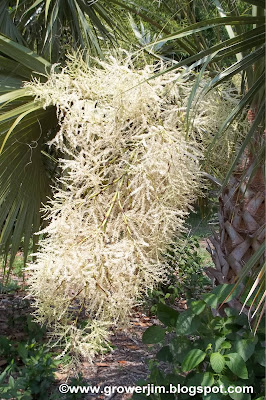One of the most attractive, durable, and wildlife-friendly palms to have in your landscape is the
Sabal palmetto. The early summer bloom spikes are 5-6 feet long, and pleasantly fragrant.
Thousands of creamy white flowers open on each spike, and attract an equal number of flying insects foraging for pollen and nectar. Here's a 20 second video showing the multitude of insects visiting these blooms. You can really only see the largest of the flying insects, but there are about 10 times as many bugs present as what are visible in the video.
By late fall, the small black fruits are ripe, and provide a feast for squirrels, raccoons, bear, deer, and many different species of birds.

Known as the sabal palm or cabbage palm, it is the state tree of Florida and South Carolina. It is tolerant of both drought and flood, and survives brush fires with only superficial damage.
This plant is native to the southeastern U.S., Cuba, and the Bahamas. It is recommended for USDA Zones 8-10.
Sabal palmetto typically reaches a height of about 50 feet, with a trunk diameter of up to two feet. Leaves are up to 12 feet long, with drooping tips.
The palm fronds are usually self-cleaning. The petioles snap off when brown and brittle, leaving a distinctive "boot" attached to the trunk.
There is some genetic variability in how long the boots will remain. Some plants keep them for the life of the palm, while others quickly fall off, leaving a "slick" trunk. Debris collects in the boots of older palms, often providing a home for ferns, tillandsias, and other small plants.
The large leaves were traditionally used by the Seminole Indians to thatch roofs.





























